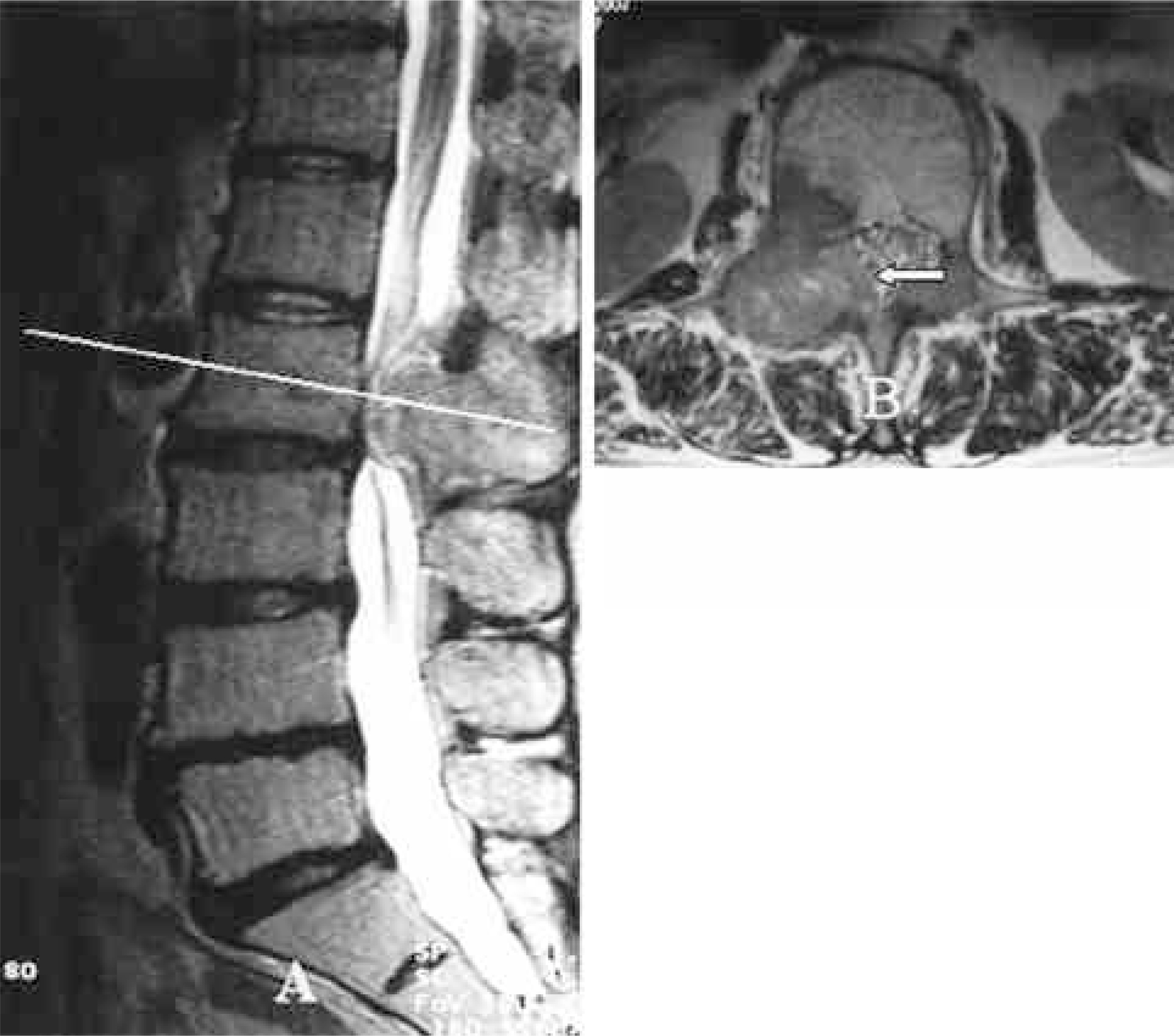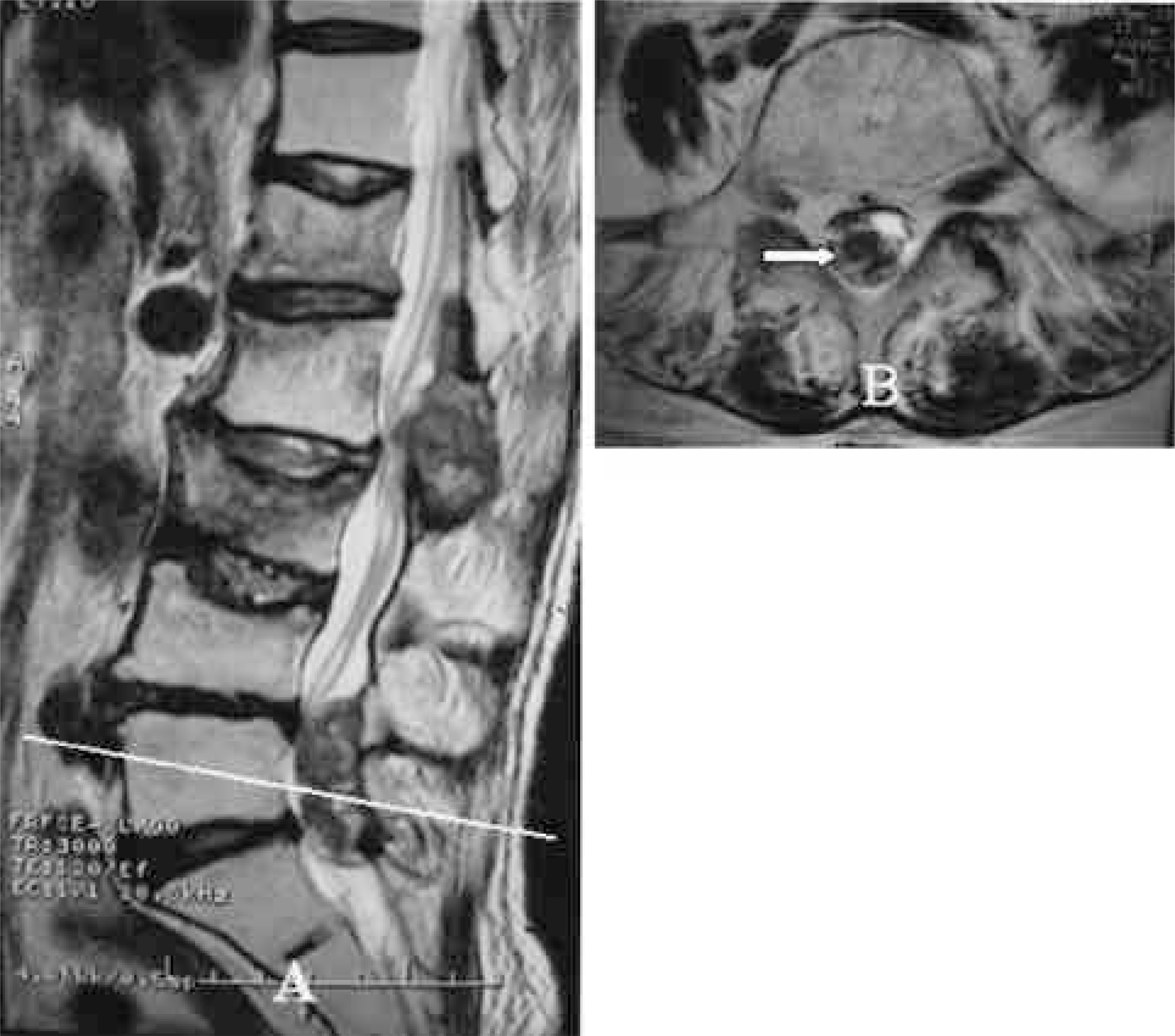J Korean Soc Spine Surg.
2005 Mar;12(1):83-86. 10.4184/jkss.2005.12.1.83.
Distant Intradural Metastasis by Direct Seeding Through Dural Opening From the Metastasis of Rectal Cancer
- Affiliations
-
- 1Department of Orthopedic Surgery, Kang-Nam St. Mary's Hospital College of Medicine, The Catholic University of Korea, Seoul, Korea. kyh@cmc.cuk.ac.kr
- KMID: 1897026
- DOI: http://doi.org/10.4184/jkss.2005.12.1.83
Abstract
- Few cases of intradural metastasis of a non-neurogenic origin, without antecedent cerebral metastasis, have been reported. To the best of our knowledge; however, this is the first reported case of distant tumor metastasis via seeding to the intradural space through a dural opening, which formed a tumor mass without antecedent brain metastasis at a different spine level. The medical records and imaging studies of a 67-year-old woman suffering from lower back pain and paresis of the lower extremities, were reviewed. She had previously had rectal cancer. A decompressive laminectomy and excision of the intradural mass were performed. The histopathology study confirmed her original diagnosis.
Keyword
MeSH Terms
Figure
Cited by 1 articles
-
Clinical Characteristics and Surgical Results of Spinal Intradural Tumor
Whoan Jeang Kim, Je Yun Koo, Kyoung Wan Bae, Jong Won Kang, Kun Young Park, Sung Il Kang, Won Sik Choy
J Korean Soc Spine Surg. 2011;18(2):43-50. doi: 10.4184/jkss.2011.18.2.43.
Reference
-
1). Frey I, Le Breton C, Lefkopoulos A, et al. Intradu ral extramedullary spinal canal secondary neplasm: MR findings in 30 patients. Eur Radiol. 1998; 8:1187–1192.2). Mosdal C, Bang F. Intradural spinal metastasis. Acta Neurochir (Wien). 1981; 56:107–110.3). Mak KH, Kwok CK. Intradural spinal metastasis from renal cell carcinoma: A case report. J Orthop Surg (Hong Kong). 2001; 9:57–61.
Article4). Feiring EH, Hubbard JH. Spinal cord compression resulting from intradural carcinoma. J Neurosurg. 1965; 23:636–638.
Article5). Perrin RG, Livingston KE, Aarabi B. Intradural extramedullary spinal metastasis. A report of 10 cases. J Neurosurg. 1982; 56:835–837.6). Batson OV. The role of vertebral veins in metastatic processes. Ann Intem Med. 1940; 16:38–45.7). Batson OV. The function of vertebral veins and their role in the spread of metastasis. Ann Surg. 1940; 112:138–149.8). Benson DF. Intramedullary spinal cord metastasis. Neurology. 1960; 10:281–287.
Article9). Simpson RK, Godman JC, Ehni G. Nas opha ry ngeal carcinoma metastatic to the cauda equina. Surg Neurol. 1986; 26:306–310.10). Bilkra G. Intradural herniated lumbar disc. J Neurosurg. 1969; 31:676–679.11). Hodge CJ, Binet EF, Kieffer SA. Intradural herniation of lumbar intervertebral disc. Spine. 1978; 3:353–356.12). Chow TS, McCutcheon IE. The surgical treatment of metastatic spinal tumors within the intradural extramedullary compartment. J Neurosurg. 1996; 85:225–230.
Article
- Full Text Links
- Actions
-
Cited
- CITED
-
- Close
- Share
- Similar articles
-
- Distant Metastasis Identified Immediately after Preoperative Chemoradiotherapy for Locally Advanced Rectal Cancer
- Sacral Intradural Cysticercosis Misdiagnosed as Brain Tumor Metastasis
- Survival Outcomes and Predictors for Recurrence of Surgically Treated Brain Metastasis From Non-Small Cell Lung Cancer
- A Case of Appendicular and Rectal Metastasis from Gastric Cancer Detected by Endoscopic Resection
- Clinical Implication of Lateral Pelvic Lymph Node Metastasis in Rectal Cancer Treated with Neoadjuvant Chemoradiotherapy




